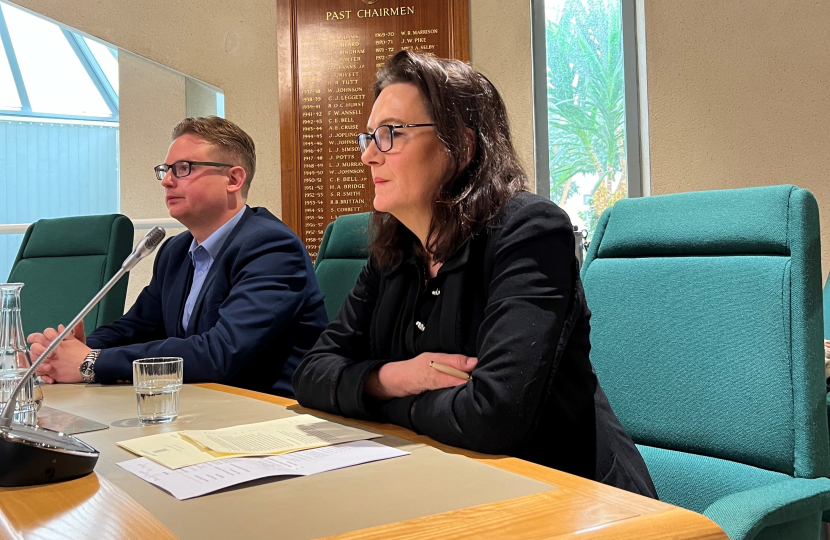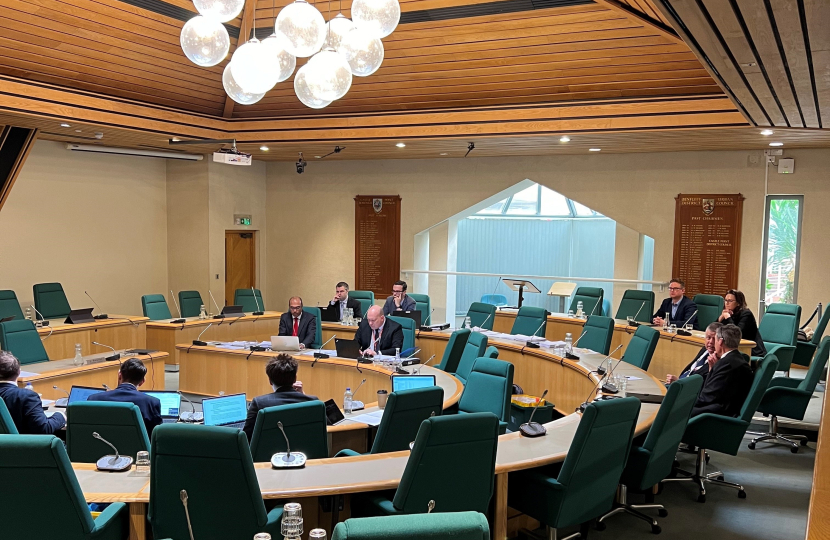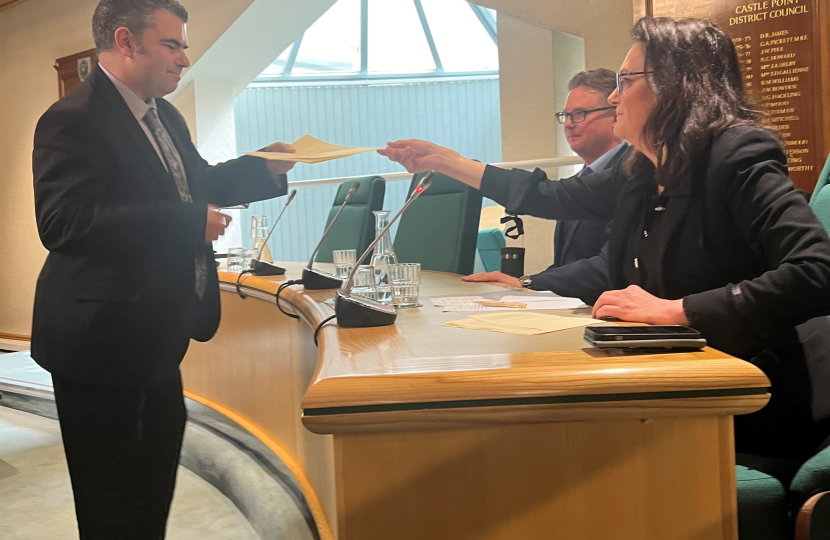Rebecca Harris attended the Planning Appeal this morning, at Castle Point Council.
Speaking for residents at a planning appeal hearing against developers plans to build 56 houses on pristine Green Belt South of Daws Heath Road.
Planning Appeal: APP/M1520/W/23/3329585 Site Address: Land South of Daws Heath Road, Thundersley, Benfleet, Essex SS7 2TA
Proposed Development: Outline application for up to 58 dwellings with associated vehicular access, parking, public open space, play space and attenuation basins, together with landscaping enhancements (all matters reserved except access)
The full text on the speech is as follows:
Thank you for kindly allowing me to speak so early in your proceedings today, enabling me to represent my constituents here this morning and again back in Westminster later today.
This is an application for development on a pristine piece of Green Belt that not only provides great visual amenity to residents but practical and physical utility as stables and riding fields for horses. No doubt, if you have visited the site, you yourself may have met one of the beautiful brown horses that canter and graze around the fields. The site consists of truly beautiful lush green fields teeming with wildlife, fringing tall ancient woodland. If you were to close your eyes and picture the ideal vision of Green Belt land, the embodiment of the very concept planners had in mind when they designated the Green Belt in the 1930s, you would be picturing this land South of Daws Heath Road. It would be a travesty if this appeal were to be upheld and this pristine piece of Green Belt were to be lost under bricks and mortar.
Sentiment aside, however,
Firstly, I believe this development is inappropriate because it is Green Belt and the appellants have not proven that special circumstances exist that would outweigh the very strong protections for Green Belt enshrined in Government planning policy,
Secondly, I believe this appeal is inappropriate because it is clearly a case of developers looking to exploit Castle Point Borough Council’s current lack of a draft local plan when the Council is actively in the process of developing one, and thirdly, I believe the assertions made in the developer’s Statement of Case relating to Government policy and the subtle insinuations about the close-mindedness of councillors when it comes to decisions made in the planning committee, are inappropriate, unjustified, and just plain wrong.
I will go over each of these points in more detail.
Paragraph 11 of the National Planning Policy Framework which discusses the 'Presumption in favour of sustainable development' which I also understand is referred to as ‘the tilted balance’, sets out circumstances where the balancing exercise decision-makers undertake should be weighted towards granting permission. This is the case where there are no relevant policies in the Development Plan or the relevant policies are 'out of date' such as Castle Point. These circumstances become a material consideration, which 'tilts' the balancing exercise from a neutral balance to one where there must be compelling reasons for permission to be withheld.
Footnote 7 on the paragraph lists types of protected areas or assets of particular importance that provide a clear reason for refusing the development. The second clear example on that list after sites of Special Scientific Interest is land designated as Green Belt.
The site is indeed in Green Belt and section D, subsection 1 of this paragraph clearly applies. According to the ‘tilted balance’ detailed in the NPPF, planning permission does not have to be granted, and the Development Management Committee of Castle Point were acting in accordance with the NPPF when they refused this application.
The Council in their Statement of Case has eloquently stated that although nobody can contest the Council has a large amount of unmet housing need and that has to be given weight when determining if very special circumstances to justify development exist, this has to be weighed against harm to the Green Belt caused by this application in particular.
The Council are accurate when they identify that this Green Belt fulfils the functions of:
- checking the unrestricted sprawl of large built-up areas
- safeguarding the countryside from encroachment, and
- preventing neighbouring settlements from merging, namely Thundersley and Daws Heath.
The first two functions are self-explanatory and have been tested in various ways at planning appeals before and I will leave it up to learned Counsel for Castle Point to argue on those points.
However, going through the appellants' case over several hours late at night in my office in the House of Commons, it struck me that the function of Green Belt in preventing neighbouring towns from merging was not relevant in ANY of the cases sighted as precedent which the appellant has listed in their Statement of Case to support their argument.
Examining each of the appeal judgements they listed as footnotes in order:
Footnote 7: Paragraph 27 of the North of Boroughbridge Road, South of Millfield Lane Appeal judgement said the Stated Development was surrounded by urban extent and therefore, and I quote ‘Accordingly it would not visually or physically extend development towards nearby settlements, including Upper and Nether Poppleton.’
Footnote 8: For the appeal at Rhoda Road, literally 5 minutes down the road from this very building, while I disagree that that appeal should have been granted, but I also didn’t need to look to know there is still a large swathe of Green Belt between the urban development at the bottom of Bread and Cheese Hill and the top of it due to the large amount of ancient woodland separating the settlements.
Footnote 9: For the appeal at Kennel Lane in Billericay in judgement paragraph 19 it was determined that again a far greater extent of development would be necessary to see a merger of settlements.
Footnote 10: For the appeal regarding Land Off Bullens Green Lane, preventing neighbouring towns from merging as a function of the Green Belt in question was not even mentioned as relevant in the appeal judgement.
Footnote 11: Land South of Heath Lane, the only function of Green Belt relevant to that case was preventing encroachment on the countryside as per paragraph 23 of that judgement.
Footnote 12: Land to the west of Berley in Wharfdale, the appeal judgement for that case confirms there is no merging of towns in paragraph 654.
Footnote 14: Relating to the Hart Road appeal literally half a mile due North of this building, the granting of which I believe was also mistaken, but again I know that the Green Belt on that site was not preventing neighbouring settlements from merging.
So, of the seven appeal judgements on Green Belt cited as precedent to support the appellants’ Statement of Case, not a single one confirms that the proposals would have seen the merging of towns identified as a key function of Green Belt.
In this case being examined at Appeal today the Council have outlined on page 29 of their Statement of Case how development of this site would lead to the merger of the distinct settlements of Thundersley and Daws Heath.
The appellants don’t acknowledge this or address it as a harm or relevant function of the Green Belt in this instance.
It is clear that the Council and with them also the residents of Castle Point, view this as a function of Green Belt that should be attributed weight and the appellant has no answer.
When we think about the analogy of the scales implicit in the balance test for the presumption in favour of sustainable development, the appellant has said the substantial weight of unmet market and affordable need on their side of the scale outweighs harms to the Green Belt, without acknowledging or challenging the extra weight on the other side of the scale added by the harm to the Green Belt done by this application compromising the key purpose of preventing the merger of neighbouring towns.
I urge you to please take that extra weight into utmost consideration when making your judgement.
(2)
Moving on to the timing of this appeal, it is clear that the appellant are looking to exploit the fact that while the Council do not have a published draft local plan in place that can be afforded legal weight in planning appeals, they are vulnerable to piecemeal speculative development on the Green Belt.
The Council have made it clear that they are working on a plan and are due to release a draft of it in the coming months.
The Council have, as allowed and encouraged by the Government, come up with a draft report into their own housing need that will become part of the local plan evidence base. The Council will have the opportunity to apply constraints as they see fit and select development sites they deem appropriate to meet that need where possible. According to the Local Development Framework, a draft of the plan will be put together for public consultation in the next few months.
I find it morally objectionable that the appellants through submitting this appeal are looking to subvert the democratic will of my residents expressed through their Councillors now, based on evidence that is years old and I have no doubt out of date.
I urge you to let my residents have their voice heard through their elected Councillors as to the future shape of the Borough they live in through the development of a local plan and not allow opportunistic developers to deprive them of that voice through speculative planning applications such as this.
(3)
Finally, I take issue with some of the assertions made in the statement of case that they use as arguments to support this appeal.
Firstly, the assertion made in paragraph 1.10 of their Statement of Case, which when talking about the appellants' motivation for submitting this appeal states and I quote: “The Council’s increasingly clear stance in respect of applications for development in the Green Belt, which suggested a draconian, flawed position, contrary to national policy.”
Now, as a Member of Parliament, you have to be a bit of a jack of all trades and a master of none because of the breadth of issues you have to contend with. However, having been the Member of Parliament for this constituency for fourteen years and having served as a member of His Majesty’s Government as a Government Whip managing the business in the House of Commons, I think it’s fair to say I can at least be classed as an expert on two things:
1) The constituency of Castle Point and the views of its 90,000 or so residents
2) And funnily enough the policies of the Government I serve in
I tell you now that in the view of the residents of Castle Point, including myself, it is not a draconian or flawed position for the Council to fight to defend the Green Belt sites local residents treasure and that are central to the semi-rural character of our Borough. It is also not contrary to Government policy for the Council to vote against inappropriate development on our Green Belt and the Government has been very clear about the rights they have, and in fact the imperative they are under to do so!
I also take issue with an inference made in their Statement of Case relating to the Leader of the Council.
I am sure that both The Leader and his entire Council administration he leads are utterly mortified that comments he made in the press have been used as legal ammunition by the appellants in their case. Although the sentiment he expressed is one I and I know many Castle Point residents agree with, I believe he is no doubt aware that he should have perhaps exercised more caution when speaking as a leader of a local authority to separate his comments on blanket policy from the quasi-legal realm of the consideration of individual planning applications.
However, I take issue with the fact that his comments could be used to suggest that Councillors on the Development Control Committee are minded as decision makers to summarily reject planning applications on Green Belt contrary to their legal obligation to look at each application on its individual merits and approach each and every application before them with an open mind. That would be a very high legal bar to prove, which is no doubt why the appellant has carefully just avoided making such an accusation. I have to say I am appalled at this insinuation and would want the appellant to clarify just what precisely they meant by their comments if this interpretation of them is incorrect.
I also believe there are other inaccuracies that the appellants have included to justify their case, such as where the appellant contends that the Council does not appear to have conducted a ‘call of sites’ since it withdrew the last draft local plan in 2022. On 24th November 2023, the Deputy Leader said in a statement to Full Council that the Council employed an AI company to trawl all the urban areas and identify hundreds of sites that met certain criteria and could be developed or redeveloped. He further went on to add that the initial phase of this work has been completed and Officers are in the process of contacting the landowners of the sites identified to see whether they have any plans for development or open their eyes to the potential and test what the development potential is. There are many other inaccuracies I have identified but I will leave them for the Council’s legal Counsel to raise on Castle Point Borough Council’s behalf.
To summarise on behalf of the residents of Castle Point, I ask you to preserve their voice in the shaping of the future of our Borough, to acknowledge the huge legal weight given to Green Belt protection in planning law and the importance of this individual Green Belt site in this application to the character and environmental balance of the area by wholeheartedly rejecting this Appeal.
Thank you for your time and for allowing me the opportunity to represent my residents on this very important matter.



